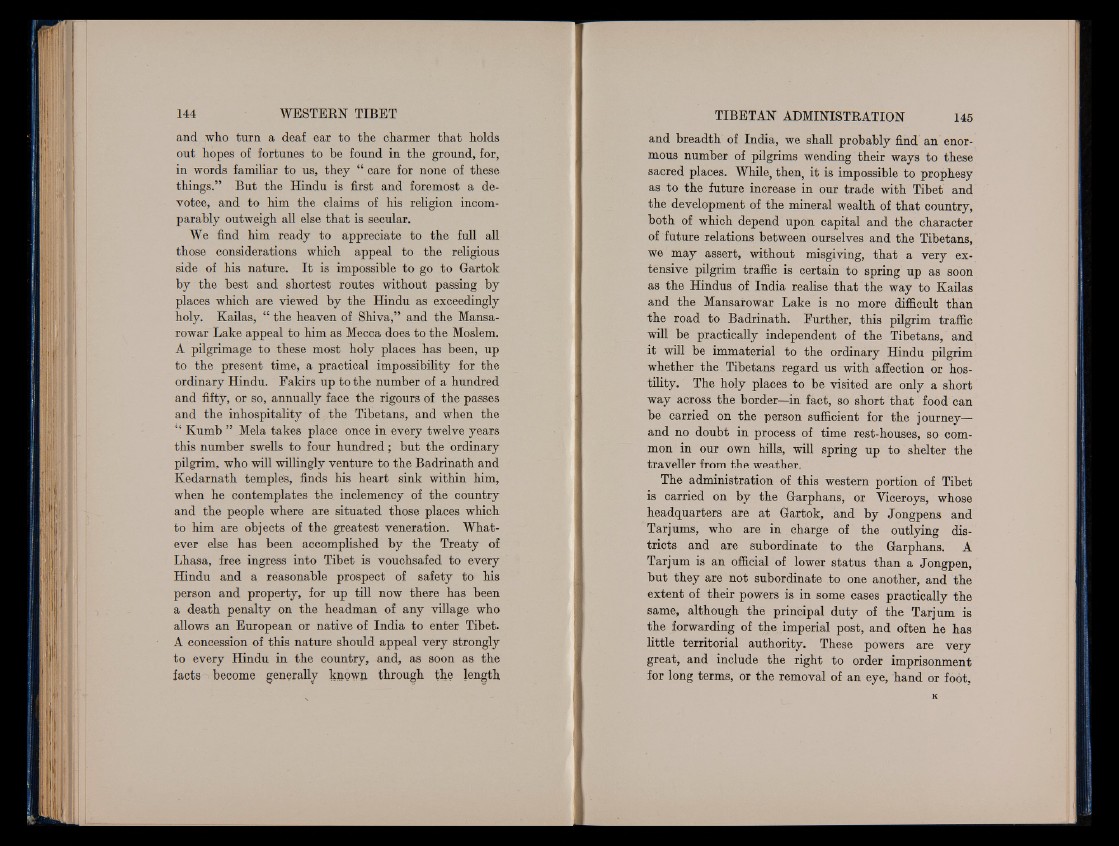
and who turn a deaf ear to the charmer that holds
out hopes of fortunes to be found in the ground, for,
in words familiar to us, they “ care for none of these
things.” But the Hindu is first and foremost a devotee,
and to him the claims of his religion incomparably
outweigh all else that is secular.
We find him ready to appreciate to the full all
those considerations which appeal to the religious
side of his nature. I t is impossible to go to G-artok
by the best and shortest routes without passing by
places which are viewed by the Hindu as exceedingly
holy. Kailas, “ the heaven of Shiva,” and the Mansa-
rowar Lake appeal to him as Mecca does to the Moslem.
A pilgrimage to these most holy places has been, up
to the present time, a practical impossibility for the
ordinary Hindu. Fakirs up to the number of a hundred
and fifty, or so, annually face the rigours of the passes
and the inhospitality of the Tibetans, and when the
S? Kumb ” Mela takes place once in every twelve years
this number swells to four hundred; but the ordinary
pilgrim, who will willingly venture to the Badrinath and
Kedarnath temple's, finds his heart sink within him,
when he contemplates the inclemency of the country
and the people where are situated those places which
to him are objects of the greatest veneration. Whatever
else has been accomplished by the Treaty of
Lhasa, free ingress into Tibet is vouchsafed to every
Hindu and a reasonable prospect of safety to his
person and property, for up till now there has been
a death penalty on the headman of any village who
allows an European or native of India to enter Tibet.
A concession of this nature should appeal very strongly
to every Hindu in the country, and, as soon as the
facts become generally known through the length
and breadth of India, we shall probably find an enormous
number of pilgrims wending their ways to these
sacred places. While, then, it is impossible to prophesy
as to the future increase in our trade with Tibet and
the development of the mineral wealth of that country,
both of which depend upon capital and the character
of future relations between ourselves and the Tibetans,
we may assert, without misgiving, that a very extensive
pilgrim traffic is certain to spring up as soon
as the Hindus of India realise that the way to Kailas
and the Mansarowar Lake is no more difficult than
the road to Badrinath. Further, this pilgrim traffic
will be practically independent of the Tibetans, and
it will be immaterial to the ordinary Hindu pilgrim
whether the Tibetans regard us with affection or hostility.
The holy places to be visited are only a short
way across the border—in fact, so short that food can
be carried on the person sufficient for the journey—
and no doubt in process of time rest-houses, so common
in our own hills, will spring up to shelter the
traveller from the weather.
The administration of this western portion of Tibet
is carried on by the Garphans, or Viceroys, whose
headquarters are at Gartok, and by Jongpens and
Tarjums, who are in charge of the outlying districts
and are subordinate to the Garphans. A
Tarjum is an official of lower status than a Jongpen,
but they are not subordinate to one another, and the
extent of their powers is in some cases practically the
same, although the principal duty of the Tarjum is
the forwarding of the imperial post, and often he has
little territorial authority. These powers are very
great, and include the right to order imprisonment
for long terms, or the removal of an eye, hand or foot,